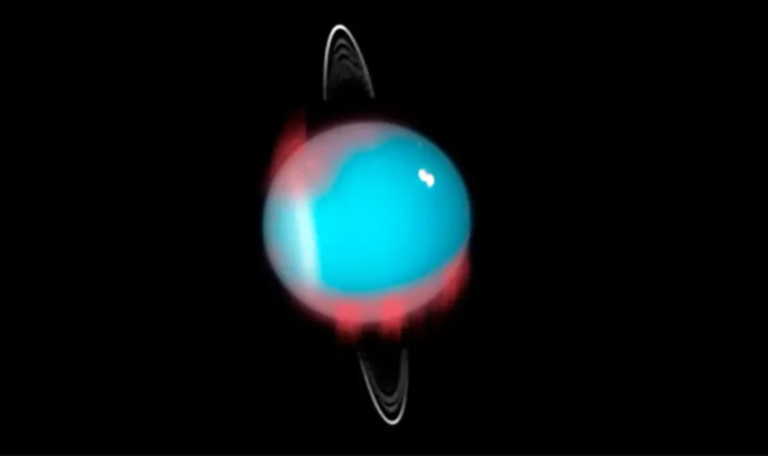Infrared Auroras on Uranus Might Provide Clues to Habitable Worlds
University of Leicester astronomers have, for the first time, verified the existence of an infrared aurora on the frigid outer planet Uranus. This groundbreaking discovery has the potential to unravel the mysteries surrounding the magnetic fields of our solar system’s planets and may even provide insights into the possibility of life on distant worlds.
The team of scientists, backed by the Science and Technology Facilities Council (STFC), has successfully recorded the initial measurements of Uranus’s infrared (IR) aurora, marking a significant development since investigations commenced in 1992. While observations of Uranus’s ultraviolet (UV) aurorae date back to 1986, the confirmation of the IR aurora had remained elusive until now. The team’s findings were published on October 23 in the journal Nature Astronomy.
Magnetic Misalignment and Aurorae
Uranus and Neptune, the ice giants of our solar system, stand out due to the peculiar misalignment of their magnetic fields with the axes of their rotation. While scientists are still in search of an explanation for this phenomenon, potential clues may be found in the auroras of Uranus.
Auroras are produced by highly energetic charged particles, directed down and colliding with a planet’s atmosphere through the magnetic field lines. On Earth, this process manifests as the spectacular Northern and Southern Lights. However, on planets like Uranus, where the atmosphere is predominantly composed of hydrogen and helium, the resulting aurora emits light beyond the visible spectrum, specifically in wavelengths such as infrared (IR).
Methods and Findings
The research team utilized infrared auroral measurements by examining specific wavelengths of light emitted from Uranus through the Keck II telescope. This process involved analyzing the emitted light, comparable to a barcode, with a focus on the lines emitted by a charged particle called H3+. In the infrared spectrum, these lines vary in brightness based on the temperature and density of the particle, essentially serving as a thermometer for the planet.
Their observations uncovered noticeable increases in H3+ density within Uranus’s atmosphere, accompanied by minimal changes in temperature. This pattern aligns with ionization triggered by the presence of an infrared aurora. This not only enhances our comprehension of the magnetic fields of the outer planets in our solar system but also holds potential significance in identifying other planets capable of supporting life.
Implications and Future Studies
Lead researcher Emma Thomas, a PhD student in the University of Leicester School of Physics and Astronomy, remarked, “The temperatures of gas giant planets, including Uranus, surpass models’ predictions by hundreds of degrees Kelvin/Celsius when considering only solar warming. This leaves us with the intriguing question of why these planets are much hotter than anticipated. One theory proposes that the energetic aurora is responsible, generating and directing heat from the aurora toward the magnetic equator.”
“A majority of discovered exoplanets so far belong to the sub-Neptune category, sharing physical similarities with Neptune and Uranus in terms of size. This implies potential similarities in magnetic and atmospheric characteristics. By examining Uranus’s aurora, which directly links to both the planet’s magnetic field and atmosphere, we can make predictions about the atmospheres and magnetic fields of these worlds, shedding light on their potential habitability.”
“This study represents the culmination of 30 years of auroral research at Uranus, unveiling the infrared aurora and initiating a new era of aurora investigations at the planet. Our findings will expand our understanding of ice giant auroras and enhance our knowledge of planetary magnetic fields in our solar system, at exoplanets, and even on Earth.”
The results may also offer insights into a rare Earthly phenomenon known as geomagnetic reversal, where the north and south poles switch hemisphere locations.
Emma further notes, “We lack extensive studies on this phenomenon, and therefore, we are uncertain about its impacts on systems reliant on Earth’s magnetic field, such as satellites, communications, and navigation. However, this process occurs daily at Uranus due to the unique misalignment of the rotational and magnetic axes. Ongoing research into Uranus’s aurora will provide data on what to expect when Earth undergoes a future pole reversal and the implications for its magnetic field.”
Sources:
“Detection of the infrared aurora at Uranus with Keck-NIRSPEC” 23 October 2023, Nature Astronomy.
DOI: 10.1038/s41550-023-02096-5
Do not forget to share your opinion with us to provide you with the best posts !




0 Comments